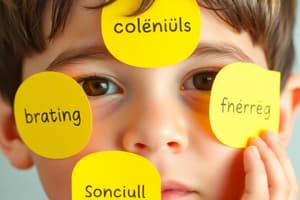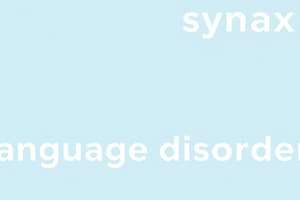Podcast
Questions and Answers
What is the main focus of morphology?
What is the main focus of morphology?
The structure of words
What are the two main parts of grammar?
What are the two main parts of grammar?
Morphology and syntax
What does the prefix "un" mean?
What does the prefix "un" mean?
not
What are the parts of the word "unbelievable"?
What are the parts of the word "unbelievable"?
How is a word different from a lexeme? For example, what is the lexeme for the word "running"?
How is a word different from a lexeme? For example, what is the lexeme for the word "running"?
The word "friend" can be further divided into smaller meaningful parts.
The word "friend" can be further divided into smaller meaningful parts.
What are the two types of morphemes?
What are the two types of morphemes?
Which of these morphemes is an example of a lexical morpheme?
Which of these morphemes is an example of a lexical morpheme?
Morphemes can be seen, heard, or even written down.
Morphemes can be seen, heard, or even written down.
Blended words, for example, "Instagram", are made up of multiple roots.
Blended words, for example, "Instagram", are made up of multiple roots.
What makes "unbelievable" a polymorphemic word? What is an example of a monomorphemic word?
What makes "unbelievable" a polymorphemic word? What is an example of a monomorphemic word?
What is an example of an inflectional morphology change?
What is an example of an inflectional morphology change?
What is an example of derivational morphology?
What is an example of derivational morphology?
Inflectional morphemes are often used in advertising.
Inflectional morphemes are often used in advertising.
What is the main purpose of inflectional morphology?
What is the main purpose of inflectional morphology?
Inflectional morphology is more common in English than in Latin.
Inflectional morphology is more common in English than in Latin.
What is the main purpose of derivational morphology?
What is the main purpose of derivational morphology?
What is the grammatical function of the morpheme '-s'?
What is the grammatical function of the morpheme '-s'?
The morpheme '-s' is only used to indicate possession.
The morpheme '-s' is only used to indicate possession.
What is the main focus of derivational morphology?
What is the main focus of derivational morphology?
What is the main purpose of the study of morphemes, morphs, and allomorphs?
What is the main purpose of the study of morphemes, morphs, and allomorphs?
Describe the difference between morphemes and morphs.
Describe the difference between morphemes and morphs.
What is an allomorph? Why is it important?
What is an allomorph? Why is it important?
Allomorphs are always irregular.
Allomorphs are always irregular.
Irregular verbs always have the same form for the present, past, and past participles.
Irregular verbs always have the same form for the present, past, and past participles.
Flashcards
Morphology
Morphology
The study of how words are structured.
Grammar
Grammar
A set of rules that govern how we understand language.
Morpheme
Morpheme
The smallest meaningful unit of language.
Root
Root
Signup and view all the flashcards
Affix
Affix
Signup and view all the flashcards
Prefix
Prefix
Signup and view all the flashcards
Suffix
Suffix
Signup and view all the flashcards
Monomorphemic Word
Monomorphemic Word
Signup and view all the flashcards
Polymorphemic Word
Polymorphemic Word
Signup and view all the flashcards
Lexeme
Lexeme
Signup and view all the flashcards
Inflection
Inflection
Signup and view all the flashcards
Inflectional Morphology
Inflectional Morphology
Signup and view all the flashcards
Derivational Morphology
Derivational Morphology
Signup and view all the flashcards
Grammatical Morpheme
Grammatical Morpheme
Signup and view all the flashcards
Lexical Morpheme
Lexical Morpheme
Signup and view all the flashcards
Morph
Morph
Signup and view all the flashcards
Allomorphs
Allomorphs
Signup and view all the flashcards
‘s Morpheme
‘s Morpheme
Signup and view all the flashcards
Irregular Verbs
Irregular Verbs
Signup and view all the flashcards
Word Blending
Word Blending
Signup and view all the flashcards
Syntax
Syntax
Signup and view all the flashcards
Noun-Verb Conversion
Noun-Verb Conversion
Signup and view all the flashcards
Derivative
Derivative
Signup and view all the flashcards
Homonyms
Homonyms
Signup and view all the flashcards
Homographs
Homographs
Signup and view all the flashcards
Homophones
Homophones
Signup and view all the flashcards
Antonym
Antonym
Signup and view all the flashcards
Synonym
Synonym
Signup and view all the flashcards
Connotation
Connotation
Signup and view all the flashcards
Denotation
Denotation
Signup and view all the flashcards
Study Notes
English Morphosyntax
- Morphology is the part of grammar focusing on word structure.
- Grammar is a set of rules for understanding language, with two main parts:
- Morphology (studying words)
- Syntax (studying sentence formation)
What is a Word?
- In Morphology, a word is a single language unit for writing or speaking.
- Words like "friend" and "friends" are different, because "friend" cannot be broken down further, whereas "friends" has an added "s" for plural.
- Morphology divides "word" into two:
- Word: The smallest meaningful unit in language.
- Lexeme: The dictionary form of a word (e.g., "run" is the lexeme, variants like "runs" or "running" are different forms).
Word Parts (Morphemes)
- Morphemes are the smallest meaningful units forming words.
- They can be:
- Lexical: carrying the main meaning (e.g., "friend" in "friends").
- Grammatical: Showing relationships between words (e.g., "-s" in "friends" meaning plural).
- Morphemes are abstract ideas that create words.
Examples of Morphemes
- Unbelievable:
- Un-: Negative prefix ("not")
- Believe: Base word
- able: Suffix ("able to")
- Friend-s:
- Friend: Base word (person)
- -s: Suffix (plural)
Special Cases (Word Formation)
- Blended Words: Words like Instagram (formed from combining "instant" and "photograph").
- Analyzing Words: Unforgivable has three morphemes:
- Un-: Prefix ("not")
- Forgiv-: Root word
- -able: Suffix ("able to")
- Polymorphemic vs Monomorphemic Words
- Polymorphemic words have multiple morphemes (e.g., unbelievable).
- Monomorphemic words have one morpheme (e.g., friend).
Types of Morphology
- Inflectional Morphology: Focuses on grammatical changes (e.g., pluralization).
- Derivational Morphology: Focuses on creating new words or meanings.
Morphemes, Morphs, and Allomorphs
- Morpheme: Abstract idea, the smallest meaningful unit in language.
- Morphs: Concrete realization of morphemes in speech/writing.
- Allomorphs: Variations of a morpheme (e.g., irregular past tense verb forms).
Inflectional Morphology
- Deals with grammatical changes to fit words into sentences (e.g., "-ing" for continuous tense, "-s" for plural).
- Grammatical inflections are not as common in English as in some other languages, sentence order is more important.
Derivational Morphology
- Studies how new words are formed (e.g., adding prefixes/suffixes).
Studying That Suits You
Use AI to generate personalized quizzes and flashcards to suit your learning preferences.




